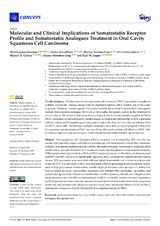Mostrar el registro sencillo del ítem
Molecular and Clinical Implications of Somatostatin Receptor Profile and Somatostatin Analogues Treatment in Oral Cavity Squamous Cell Carcinoma
| dc.contributor.author | Sanjuan-Sanjuan, Alba | |
| dc.contributor.author | Alors-Pérez, Emilia | |
| dc.contributor.author | Sánchez-Frías, Marina | |
| dc.contributor.author | Dean Ferrer, Alicia | |
| dc.contributor.author | Gahete Ortiz, Manuel D. | |
| dc.contributor.author | Heredero-Jung, Susana | |
| dc.contributor.author | Luque, Raúl M. | |
| dc.date.accessioned | 2021-10-01T11:35:20Z | |
| dc.date.available | 2021-10-01T11:35:20Z | |
| dc.date.issued | 2021 | |
| dc.identifier.uri | http://hdl.handle.net/10396/21767 | |
| dc.description.abstract | Oral squamous cell carcinoma (OSCC) incidence has increased by 50% over the last decade. Unfortunately, surgery and adjuvant radiotherapy and chemotherapy are still the mainstream modality of treatment, underscoring the need for alternative therapies. Somatostatin-analogues (SSA) are efficacious and safe treatments for a variety of tumors, but the presence of somatostatin-receptors (SSTs) and pharmacological effects of SSA on OSCC are poorly known. In this study, we demonstrated that SST2 and SST3 levels were significantly higher in OSCC, compared to adjacent healthy control tissues. SST2 expression was associated with less regional metastasis and a lower recurrence rate. Moreover, SST2 was elevated in OSCC and associated with histopathological good prognosis factors, such as high peritumoral inflammation, smaller depth of invasion, and expansive vs. infiltrative front of tumor invasion. Importantly, treatment with different SSA (octreotide, lanreotide, and pasireotide) significantly reduced cell-proliferation in OSCC primary cell cultures. Altogether, this study demonstrated that SST2 is overexpressed in OSCC vs. healthy tissues and could represent a novel prognostic biomarker, since its expression is associated with tumors that show better prognostic factors and less recurrent rate. Moreover, our data unveil clear antitumoral effects of SSAs on OSCC, opening new avenues to explore their potential as targeting therapy to OSCC. | es_ES |
| dc.format.mimetype | application/pdf | es_ES |
| dc.language.iso | eng | es_ES |
| dc.publisher | MDPI | es_ES |
| dc.rights | https://creativecommons.org/licenses/by/4.0/ | es_ES |
| dc.source | Cancers 13(19), 4828 (2021) | es_ES |
| dc.subject | Somatostatin receptors | es_ES |
| dc.subject | Oral cavity cancer | es_ES |
| dc.subject | Head and neck | es_ES |
| dc.subject | Biomarkers | es_ES |
| dc.subject | Somatostatin analogues | es_ES |
| dc.subject | Therapeutic tool | es_ES |
| dc.title | Molecular and Clinical Implications of Somatostatin Receptor Profile and Somatostatin Analogues Treatment in Oral Cavity Squamous Cell Carcinoma | es_ES |
| dc.type | info:eu-repo/semantics/article | es_ES |
| dc.relation.publisherversion | https://doi.org/10.3390/cancers13194828 | es_ES |
| dc.relation.projectID | Gobierno de España. PID2019- 105564RB-I00 | es_ES |
| dc.relation.projectID | Instituto de Salud Carlos III. FI17/00282 | es_ES |
| dc.relation.projectID | Junta de Andalucía. BIO-0139 | es_ES |
| dc.relation.projectID | Junta de Andalucía. P20_00442 | es_ES |
| dc.rights.accessRights | info:eu-repo/semantics/openAccess | es_ES |

